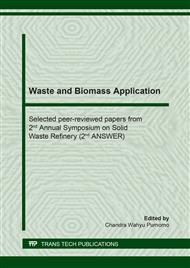[1]
N. K. Putri, Local Concerns on Plastic Bag Charge in Indonesia : Do we really care ?, in Advances in Social Science, Education and Humanities Research (ASSEHR). 98 (January 2018) 326–329.
Google Scholar
[2]
Supriyadi et al., Analysis of Development Block Paving with Plastic Waste Material Adhesive Leaves, Int. J. Adv. Sci. Res. Eng. 9, 5 (2019) 1–7.
Google Scholar
[3]
T. Landi and Arijanto, Perancangan dan uji alat pengolah sampah plastik jenis LDPE (Low Density Polyethylene) menjadi bahan bakar alternatif, J. Tek. Mesin, 5, 1 (2017) 1–8.
DOI: 10.52447/jktm.v6i1.4454
Google Scholar
[4]
M. A. Jalil, M. N. Mian, and M. K. Rahman, Using Plastic Bags and Its Damaging Impact on Environment and Agriculture: An Alternative Proposal, Int. J. Learn. Dev. 3, 4 (2013).
DOI: 10.5296/ijld.v3i4.4137
Google Scholar
[5]
M. Gogte, Are Plastic Grocery Bags Sacking the Environment?. Int. J. Qual. Res. 3, 4 (2009) 363–375.
Google Scholar
[6]
National Indonesia Standard. SNI 03-0691-1996, Bata Beton.(1996).
Google Scholar
[7]
M. Hambali, I. Lesmania, and A. Midkasna, Pengaruh Komposisi Bahan Penyusun Paving Block terhadap Kuat Tekan dan Daya Serap Airnya. J. Tek. Kim. 19, 4 (2013) 14–21.
DOI: 10.31227/osf.io/qja5n
Google Scholar
[8]
S. Pawar and S. A. Bujone, Use of Fly ash and Plastic in Paver Block. Int. Res. J. Eng. Technol. 4, 11 (2017) 1542–1547.
Google Scholar
[9]
S. K. Sohani, D. Soni, D. Shukla, A. Telang, and A. Sahu, Design of Pavement Blocks Utilizing Low Density Poly Ethylene ( LDPE ) Waste , and It's Evaluation, J. Emerg. Technol. Innov. Res. 5, 7 (2018) 1440–1444.
Google Scholar
[10]
D. P. Putra, S. T. Wicaksono, A. Rasyida, and R. Bayuaji, Studi Pengaruh Penambahan Binder Thermoplastic LDPE dan PET terhadap Sifat Mekanik Komposit Partikulat untuk Aplikasi Material Bangunan, J. Tek. ITS Vol. 7, 1 (2018) 26–30.
DOI: 10.12962/j23373539.v7i1.28337
Google Scholar
[11]
G. Lavanya and K. P. Vasantha, Experimental Study On Paver Blocks Utilize In Pet Fibres, Int. J. Adv. Eng. Res. Technol. 4, 4 (2016) 73–79.
Google Scholar
[12]
A. Daftardar, R. Patel, R. Shah, P. Gandhi, and H. Garg, Use of Waste Plastic as a Construction Material, Int. J. Eng. Appl. Sci. 4, 11 (2017) 148–151.
Google Scholar
[13]
J. Constantin, S. M. Shitote, Z. C. A. Gariy, and E. Ronoh, Influence of Coarse Aggregate on the Physical and Mechanical Performance of Paving Blocks made using Waste Plastic, Int. J. Eng. Res. Technol. 12, 6 (2019) 912–916.
Google Scholar
[14]
S. Agyeman, N. K. Obeng-Ahenkora, S. Assiamah, and G. Twumasi, Exploiting Recycled Plastic Waste as An Alternative Binder for Paving Blocks Production, Case Stud. Constr. Mater. 11 (2019).
DOI: 10.1016/j.cscm.2019.e00246
Google Scholar
[15]
B. Shanmugavalli, K. Gowtham, and P. J. Nalwin, Reuse of Plastic Waste in Paver Blocks, Int. J. Eng. Res. Technol. 6, 2 (2017) 313–315.
DOI: 10.17577/ijertv6is020162
Google Scholar
[16]
Burhanuddin, Basuki, and M. R. S. Darmanijat, Pemanfaatan Limbah Plastik Bekas untuk Bahan Utama Pembuatan Paving Block, J. Rekayasa Lingkung. 18, 1 (2018) 1–7.
DOI: 10.37412/jrl.v18i1.20
Google Scholar
[17]
A. R. Ingole, N. N. Sonole, and C. R. Thakur, Utilisation of E-Waste, Fly Ash in Manufacturing of Paver Blocks and Tiles, Int. J. Innov. Technol. Explor. Eng. 8, 10 (2019) 2392–2396.
DOI: 10.35940/ijitee.g5996.0881019
Google Scholar
[18]
F. Dervishi and E. Luga, Relation between Physical and Mechanical Properties of Concrete Paving Blocks, in The 2nd International Congress on Roads in Albania 24th‐25th of September 2015, Tirana‐Albania, (September 2016).
Google Scholar
[19]
Y. Amran, Pemanfaatan Limbah Plastik untuk Bahan Tambahan Pembuatan Paving Block sebagai Alternatif Perkerasan pada Lahan Parkir di Universitas Muhammadiyah Metro, TAPAK. 4, 2 (2015) 125–129.
DOI: 10.26418/jplp2km.v3i1.39662
Google Scholar
[20]
O. Gencel, C. Ozel, F. Koksal, E. Erdogmus, G. Martínez-Barrera, and W. Brostow, Properties of Concrete Paving Blocks Made with Waste Marble, J. Clean. Prod. 21, 1 (2012) 62–70.
DOI: 10.1016/j.jclepro.2011.08.023
Google Scholar
[21]
P. Vila, M. N. Pereyra, and Á. Gutiérrez, Compressive strength in concrete paving blocks. Results leading to validate the test in half-unit specimens, Rev. ALCONPAT. 7, 3 (2017) 247–261.
Google Scholar


